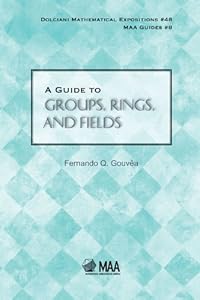 Below, Fernando Gouvêa talks about his latest book, A Guide to Groups, Rings, and Fields. Below, Fernando Gouvêa talks about his latest book, A Guide to Groups, Rings, and Fields.When you write a book, people will often ask you why you did. It makes sense: writing a book takes time and effort, so something must have kept you going until you were done. In the case of my Guide to Groups, Rings, and Fields, I had a very good but not very interesting reason: someone asked me to do it, so I did. It was hard work indeed, but I had promised. It took about two years, with most of the work being done in the summer and at other times when school was not in session. Writing a book that is basically a survey with no proofs turned out to bring special difficulties. After all, if you state something wrongly in a typical mathematics book, you will discover your mistake as you (try to) write the proof. Here, however, I wasn't going to include proofs. I found myself depending heavily on other books by authors I trust and trying hard to check everything. (There are probably still many mistakes, of course. Find some and let me know.) In many cases I tried to say something about why things work as they do, giving “shadows of proofs.” In some cases, a shadow is all one needs to reconstruct the proof, but for the big theorems that is far from true. The other thing I decided to do was to ignore the logical development. This was, after all, a book intended for after taking a course, so it was safe to assume my reader knew more than what I had done at that point. That meant making sure I had a good index, so people could look up things if they needed to. I hope I did that successfully. Was it fun? Sometimes it was. It was neat to spend time sorting out the many different definitions of “separable extension” and figuring out how to explain them. I enjoyed making decisions about messy nomenclature. For example, what is a “semisimple” ring? Some authors define it in a way that allows rings to be simple but not semisimple, which is a little annoying. I ended up deciding I could live with that, but put in a note explaining the issue. At other times, for example when I was making the index, it was just hard work. At those times what kept me going was the hope that the result would be worthwhile and useful. But that’s really up to my readers to judge. All I can do is to hope they like it. A Guide to Groups, Rings, and FieldsThis Guide offers a concise overview of the theory of groups, rings, and fields at the graduate level, emphasizing those aspects that are useful in other parts of mathematics. It focuses on the main ideas and how they hang together. It will be useful to both students and professionals. In addition to the standard material on groups, rings, modules, fields, and Galois theory, the book includes discussions of other important topics that are often omitted in the standard graduate course, including linear groups, group representations, the structure of Artinian rings, projective, injective and flat modules, Dedekind domains, and central simple algebras. All of the important theorems are discussed, without proofs but often with a discussion of the intuitive ideas behind those proofs. Those looking for a way to review and refresh their basic algebra will benefit from reading this Guide, and it will also serve as a ready reference for mathematicians who make use of algebra in their work. Purchase this book today at the MAA Store or at the MAA eBooks Store |
Friday, February 1, 2013
Fernando Gouvêa on A Guide to Groups, Rings, and Fields
Subscribe to:
Post Comments (Atom)


No comments:
Post a Comment